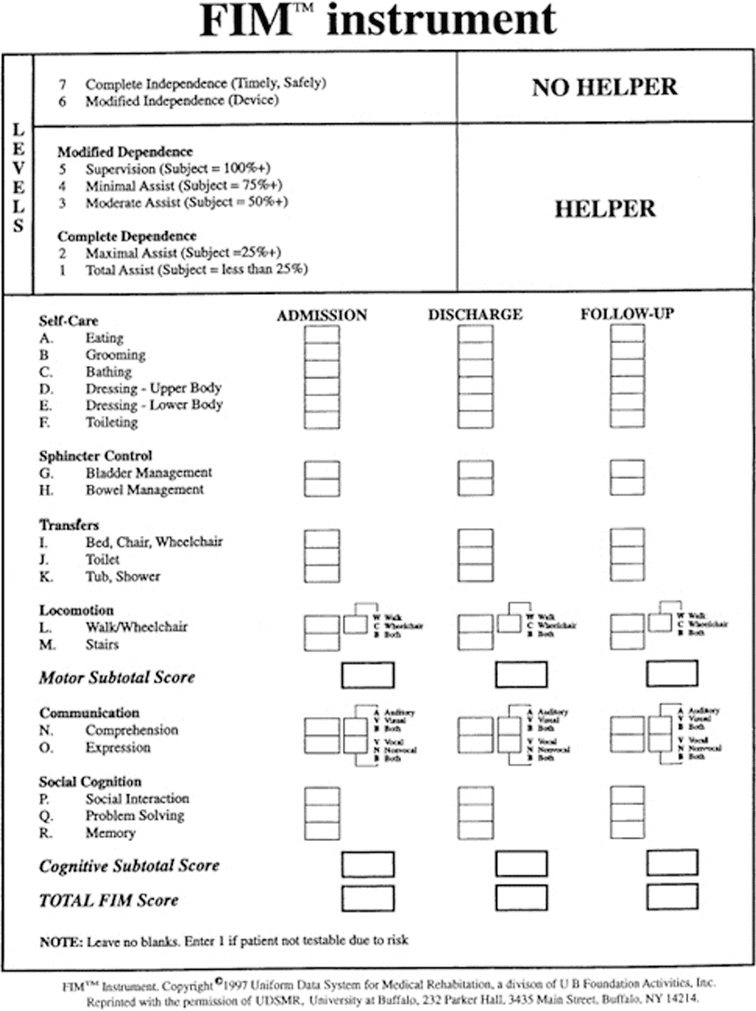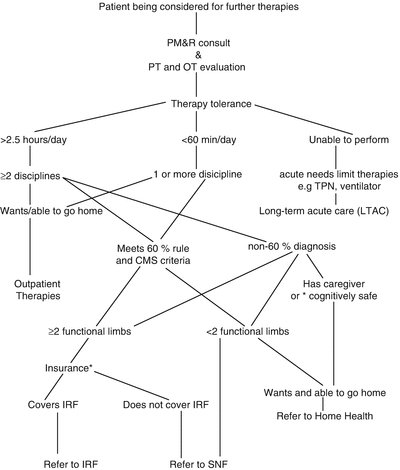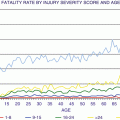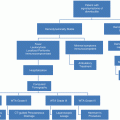Contains 18 items composed of:
13 motor tasks
5 cognitive tasks (considered basic activities of daily living)
Dimensions assessed include:
Eating
Grooming
Bathing
Upper body dressing
Lower body dressing
Toileting
Bladder management
Bowel management
Bed to chair transfer
Toilet transfer
Shower transfer
Locomotion (ambulatory or wheelchair level)
Stairs
Cognitive comprehension
Expression
Social interaction
Problem solving
Memory
Tasks are rated on a 7-point ordinal scale:
7 – Independent: able to perform task independently
6 – Modified independent: able to perform task independently, but requires extra time
5 – Supervised: able to perform task with setup, may need verbal cues for safety and sequencing
4 – Minimal assistance: Requires assistance for up to 25 % of the task
3 – Moderate assistance: Requires assistance for 26–50 % of the task
2 – Maximal assistance: Requires assistance for 51–75 % of the task
1 – Total assistance: Requires assistance for greater than 76 % of the task
Scores range from 18 (lowest) to 126 (highest) indicating level of function
Scores are generally rated at admission and discharge

Fig. 35.1
FIM instrument
The Interdisciplinary Functional Restoration Team
There are a number of allied health members who are active in the functional restoration process. Each has their own scope of practice and may make suggestions to the primary team based upon their specialty.
Occupational Therapist (OT)
Occupational therapists work with therapeutic use of everyday life activities to participate in the home, school, work, and community settings, addressing physical, cognitive, psychosocial, and other aspects of performance that affect health, well-being, and quality of life. These professionals include:
Occupational therapy aide/assistant (OTA): Aides are frequently trained on the job, while assistants have an associate-level degree; in some states, the latter clinician is required to have licensure in order to practice.
Occupational therapist (OT): A baccalaureate- or masters-level degree in an occupational therapy course of study.
Doctor of Occupational Therapy (Dr. OT): Possess a doctorate-level degree with a dissertation defense in occupational therapy.
Physical Therapist (PT)
Physical therapists examine functional limitation, disability, or other health-related conditions to determine a diagnosis, prognosis, and intervention in order to alleviate impairment through use of exercise, manual therapies, adaptive measures, and modalities. These professionals include:
Physical therapy aide/assistant (PTA): Aides are frequently trained on the job, while assistants have an associate-level degree; in some states, the latter is required to have licensure in order to practice.
Physical therapist (PT): This individual has obtained a baccalaureate- or masters-level degree in physical therapy.
Doctor of Physical Therapy (DPT): The doctorate-level degree is awarded after defending a dissertation in physical therapy.
Physiatrist
A physician (M.D., D.O.) with graduate medical education in Physical Medicine and Rehabilitation. Their educational focus is on function and independence in treating nerve, bone, and muscle injuries and illness. They are interdisciplinary team leaders, considering a broad range of medical, socioeconomic, neuropsychological, and cultural factors and barriers that affect a patient’s ability to recover and function independently. There are subspecialty designations in Traumatic Brain Injury (TBI), Spinal Cord Injury (SCI), Electrodiagnostics (EMG) and Neuromuscular Medicine, Pain Medicine, Palliative Care, and Sports Medicine. Not all physiatrists participate in acute/subacute inpatient rehabilitation, as many maintain pure outpatient, procedural-based practices. Practitioners who typically interface with hospital-based teams are in general rehabilitation and are available on a consultative basis.
Medical Social Worker (MSW)
Medical social workers have an in-depth understanding of the resources available to the patient based upon available funding, area (e.g., county) of residence, and related factors. They communicate those options to the patient and the team. They are frequently expert communicators who gather environmental and contextual information, explain the barriers and challenges to patients and their caregivers, and confirm the final discharge plan.
Speech-Language Pathologist (SLP)
These individuals have a graduate-level degree with clinical certification to treat patients with speech, swallowing, and cognitive deficits through use of therapeutic exercises, adaptive strategies, and devices.
Special Considerations in the Geriatric Population
The aging population is typically injured by lower energy force [5–9]. For example, falls are usually from standing or sitting, and compression fractures may occur after sneezing, coughing, or other normal physiologic activities. This occurs because of the effect of aging on bone metabolism resulting in osteoporosis. Furthermore, aging may be responsible for degenerative changes in various organs that will limit the patient’s potential for rehabilitation. Changes to the central nervous system that occur in the geriatric patient include a decline in cognition, gait instability, and incontinence/urgency with poor skin integrity. These preexisting conditions amplify the challenges that lead to successful community reentry once the patient recovers from an injury.
Cognitive Decline
Cognitive deficits in the aging population typically involve memory, orientation, and/or judgment [10, 11]. Memory deficits can result from primary progressive diseases, such as Alzheimer disease, or cumulative processes, such as small vessel brain disease or multiple traumatic or anoxic events. Cognitive declines are magnified with each additional injury to the head. A communication challenge to families and caregivers is to convey the idea that while the patient may seem to be independent performing routine daily activities, they may have had a decline in cognition for many years. It is important to note that short-term memory is primarily affected, while long-term memory is maintained, even with dementia.
Unfortunately, with impairment of short-term memory, new tasks taught to enforce safety in mobility may only be learned through repetition and supervision. The rehabilitation team frequently engages in scheduled tasks that are in keeping with the patient’s baseline activities and teaches safe strategies to avoid future injuries. It is not uncommon that patients perform better upon discharge home, as familiar environments can provide reminders for activities and precautions.
Gait Instability and Balance
One of the hallmarks of aging is the phenomenon of falling [13–16]. The rising incidence of idiopathic falls in the elderly is still a medical enigma and is likely multifactorial. Not uncommonly, older people fall while performing routine activities, such as getting to the bathroom or transferring while bathing. Prevention of falls includes assessing the home for loose rugs, items close to the ground (e.g., grandchildren toys, pets) that may not be seen easily in dim lighting or with a decline in vision, and smooth flooring that can lead to slippery surfaces when wet, such as tile or wood floors.
Trauma in the aging population typically occurs at lower speeds and heights. Falls from standing due to decreased balance can cause multiple fractures due to loss of bone density. Hip fractures are associated mortality rates of 50 % over 1 year. Degenerative spondylosis increases with age and contributes to a number of conditions associated with increased risk for falling. Cervical myelopathy due to stenosis or vertebral fractures can contribute to falling and result in spinal cord injury. Central cord syndrome is common and can occur with minimal injury. Atrophy of brain mass potentiates tears of bridging veins in the subdural space, which leads to further decline in mentation that can then contribute to falling. Prevention of falls and known contributing factors can help to prevent related injuries.
Prior to discharge, it behooves the clinical team to discuss with patients some of the abovementioned barriers. As quality benchmarks are predicated on decreasing readmissions to the hospital, it becomes essential to limit the ways that patients might incur further injuries in their home through prevention and preemptive preparation. Currently, the literature is equivocal on Tai Chi and other exercises for fall prevention, although it is largely accepted that the patient who stays the most active and mindful is typically less prone to fall. For patients with frequent falls, balance and proprioceptive therapies might be suggested [17, 18]. There are PTs who specialize in this complex process and can be of tremendous benefit to the patient and their families.
Continence and Urgency
Another phenomenon that is more prevalent with advancing age is that of urinary urgency. For men, prostatic hypertrophy and/or malignancy can lead to incomplete bladder emptying with the subjective sensation of urgency and frequency. For women, especially those who have had children and/or gynecological surgery, the integrity of the perineum and external sphincters may have been disrupted, leading to stress and urge incontinence [19, 20]. Additionally, many aging patients are on diuretics and other medications that alter ability to hold or excrete urine. Careful consideration to the time of day when those medications are taken will also improve duration of uninterrupted sleep at night. For example, it is not uncommon for furosemide to be prescribed as multiple doses each day. Knowing that its pharmacokinetics occurs within 6 h, the last dose each day should be taken at least 6 h before bedtime to promote good sleep hygiene. It should not be surprising that with declining dexterity in clothing management and nocturnal frequency are factors that make the bathroom one of the more dangerous rooms in the home for the elderly.
When approaching a patient with continence issues, it is important to identify whether the patient has a spastic bladder, detrusor atony, sphincter incompetency/dysynergia, or outlet obstruction. This can be identified during the inpatient setting by performing bladder scans to determine the bladder volume index and/or post-void residuals. If bladder volumes are consistently low with frequency, then the patient may benefit from an anticholinergic medication. If the bladder volumes are high post-void, it may be that the patient needs to decompress the bladder for a time and use medications that either promotes detrusor tone (e.g., bethanechol) or maintains an open sphincter to allow complete emptying (e.g., tamsulosin). A urology consult should be obtained for the patient with an enlarged prostate or intrapelvic organ prolapse. For most patients, performing bladder scans is a noninvasive way to identify and potentially treat continence problems for the aging patient.
Timed voiding is an easy way for many patients and their caregivers to manage continence. One simple way to avoid incontinence is to offer the aging patient regular times for elimination such as upon awakening, after each meal, and at bedtime. This allows for the opportunity to void and evacuate at least four times a day and is concurrent with activities already requiring supervision, set up, or assistance.
Skin Integrity
Aging is associated with a loss of subcutaneous adipose tissue. This in combination with certain medications that are commonly prescribed for the geriatric patient with concomitant cardiopulmonary disease such as anticoagulants and inhaled steroids increases the risk for skin breakdown, particularly in the sedentary patient [21]. Additionally, incontinence and widespread use of impermeable briefs trap moisture against the skin over bony prominences such as the sacrum and ischial tuberosities leading to an increased incidence of decubitus ulcers. Timed voiding, as described above, is one way to limit the use of briefs by allowing regular micturition and evacuation. For those patients with limited cognition and mobility, a condom or indwelling catheter may be considered, although these are associated with higher risks of urinary tract infections, which can also exacerbate preexisting cognitive dysfunction. It is important to counsel the patient and caregivers on the importance of checking the skin and minimizing the use of impermeable briefs when possible.
Social Structure and Support
As mentioned earlier, more and more children are opting to move away from their parents in the course of seeking educational and employment opportunities. Thus, it is not uncommon that the aging patient lives without siblings and/or children in the same community. Even when children do reside in the same neighborhood, they are not available for constant supervision or assistance of their parents. Americans are living longer because of improved medical care, but it does not necessarily mean that their quality of life or independence is preserved. Independent and assisted living communities have become more commonplace to address this sense of isolation. These facilities are not without substantial cost, however. It is not uncommon for independent living apartments to cost thousands of dollars in monthly rent. The cost escalates with additional services. To avoid leaving their home, friends and neighbors or even extended families that have remained in the area assist the elderly with ADL. However, varying levels of commitment from these individuals over the long term should be expected and clarified by a team representative.
A word should be mentioned about bereavement as a chronic condition. It is not uncommon for the aging patient to experience a slow erosion of their social support, including that from their spouse. Depression can adversely affect one’s motivation and willingness to participate. There may be a profound desire to not continue living, and efforts should be made to address the psychological barriers to successful rehabilitation. These conditions are commonly magnified by decreased metabolic and endocrine function. If psychiatry or neuropsychology services are available, consultation can be beneficial both to address the psychological issues and identify potential endocrine and/or neurophysiological contributors to the depression and dysthymia.
Consulting Rehabilitation
An appropriate rehabilitation consultation request should have the following elements:
1.
Primary and secondary diagnoses
2.
Weight-bearing restrictions and/or other restriction with their duration (e.g., sternal precautions for 6 weeks (post CABG) or NWB for 8 weeks (lower extremity fractures))
3.
Comorbidities and contraindications to relatively physically demanding activities
4.
At least one discharge plan and setting with caregivers identified as indicated
Any rehabilitation request should be accompanied with at least one viable discharge plan. Rehabilitation is what patients do when temporarily discharge to a therapy providing facility prior to transitioning to the final destination of home. Even amongst the most experienced physicians, rehabilitation can represent a “black box” where a patient is admitted and after improvement are discharged to home. Additionally, while patients can make significant functional improvements, they may not reach complete independence, especially if they have not been independent for quite some time. Consistent conveyance and communication of realistic goals and expectations is the responsibility of the physiatrist and the multidisciplinary team.
Rehabilitation Settings and Criteria for Services
There are different levels of care for rehabilitation services, just as there are different levels of care in hospitals. After admission to a rehabilitation facility, patients may require intensive therapies on a daily basis or may only tolerate a few sessions a week. The patient’s insurance carrier will frequently dictate the setting of the post-acute rehabilitation based upon the coverage provided in the insured’s policy (see Fig. 35.2). Additionally, it may be helpful to think of the different levels of rehabilitation as a continuum of care; in reality, it is common for a patient to start at an acute inpatient rehabilitation center, transition to a skilled nursing facility, then be discharged to home with home-based therapy, and transitioned to outpatient therapies. This treatment course may require several months after the index acute illness (see Table 35.2).


Fig. 35.2
Patient being considered for further therapies
Table 35.2
Overview of typical settings for continued rehabilitation efforts
Rehabilitation option | Typical length of stay | Services/requirements | Insurance coverage |
|---|---|---|---|
Inpatient rehabilitation facility (IRF)
Stay updated, free articles. Join our Telegram channel
Full access? Get Clinical Tree
 Get Clinical Tree app for offline access
Get Clinical Tree app for offline access

|



